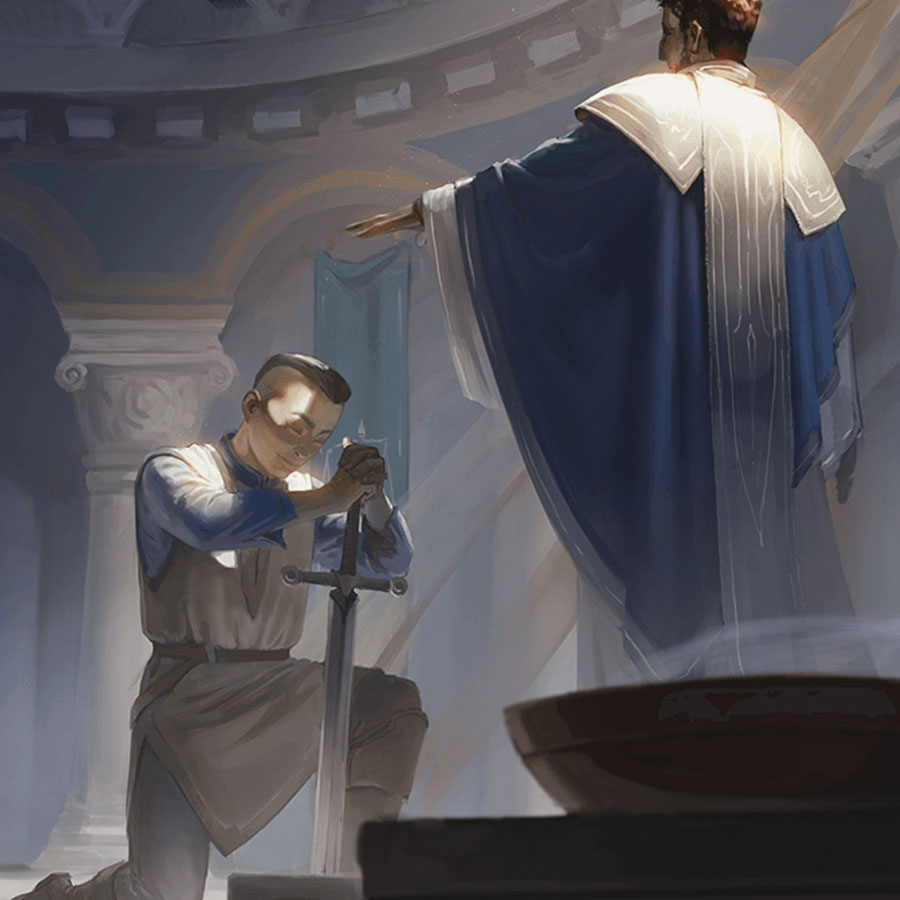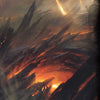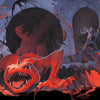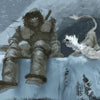How to Design and Run a D&D Trap

Written by Luke Hart
Most D&D traps go a little something like this:
All of the characters are walking down a hallway, or standing in front of a chest or a door. Either they forget to look for traps, or the rogue doesn’t find any. So, they step on the pressure plate in the hallway, turn the doorknob, or lift the chest’s lid. And then the trap goes off.
What follows is perhaps one of the most exciting and joyful moments in the game. The players all roll saving throws and then the dungeon master dolls out damage. Punishment. Retribution for their carelessness or lack of competence.
NO! That’s not exciting, and it’s not joyful. It’s one of the worst moments in the game. It feels like a DM screw job, it what it feels like. “Ah ha, you didn’t search for or find the trap, so please, take some free damage. No, no, it’s free. On the house!” The players make few, if any, meaningful choices; it’s just a punitive handing out of damage.
Thus, I submit to you that the way most traps typically are designed or implemented in D&D, rather sucks, and leads to a suboptimal game experience for players and dungeon masters alike. We really need to stop making traps like this.
So, today we’re talking about a better way to do traps in our D&D games. We’ll discuss what exactly makes a good trap for your TTRPG game. I’ll be breaking down why you should even have traps in your games to begin with, how to design a trap, and then how to run a trap at the game table.
Watch or listen to this article by clicking the video below.
Why Use Traps?
Traps serve a variety of purposes in a D&D game, and I feel that people who don't use them are missing out and some really cool stuff. First, traps can serve to introduce tension, drama, and suspense into the game. Traps can also serve as a sort of puzzle to be solved by players. Finally, traps can make combats more interesting.
And notice here that I'm using the operative word “can”—and that's very intentional. Because in many games traps don't do any of those things. Instead traps are used only as a method of resource depletion, taking away hip points, healing potions, spell slots, and the like.
And I will tell you that the first three purposes of traps that I outlined are noble and to be aspired for; but this last purpose, that of resource depletion, should be avoided. Characters resources may be depleted by traps being in the game, but that should not be the purpose of a trap's existence.
Now how to use traps to introduce tension and suspense or to make combats more interesting or to serve as a puzzle to be solved, we'll be getting into in the latter part of this article where I discuss how to run traps at your game table.
How to Design a Trap
In order to design the trap, the first question you need to ask is “who made the trap?” Knowing who made the trap gives you a perspective for deciding the specifics of the trap. Wizards we'll probably make magical traps; dwarves will make mechanical traps with stone and metal parts; and kobolds will make more primitive traps.
Next, ask yourself why the trap is even needed to begin with. Creatures don't make traps for kicks. The kobolds aren't just sitting around their cave and suddenly proclaim, “We’re bored, let's make some traps around here so that when adventurers come by they'll have something to do with their time!” No, every trap has a reason for existence. A trap maybe designed to protect something, such as the valuable. It may be intended to keep others out of a certain location. Or it might be designed to keep someone in a location. But whoever made the trap needs to have a motivating reason for doing so.
OK, so the kobolds need some traps. The next question the kobolds asked themselves is what should these traps do? And traps may fall into several main categories of function:
There are traps that simply inflict direct damage to their victims, and these are perhaps some of the least exciting sorts of traps—at least from a gameplay perspective. Then you have traps that are designed to hinder or deter. These traps may apply conditions such as reducing strength so that the victim is less able to proceed through the protected area or is more vulnerable when the kobolds launch their surprise attack. Other traps simply sound and alarm; They alert the makers of the trap that intruders have arrived. Other traps immobilize and capture their victims.
Ideally you will have a variety of trap types in your game, because as I've said time and time again on my channel, variety is king. Perhaps the adventure running now only has one trap in it, but the next adventure should have a different sort of trap in it. The key is to keep shaking things up and introducing new hazards to your players.
The next step of designing a trap is to flesh out the mechanical details. This includes deciding what triggers the trap, what effect the trap has, and what countermeasures are available to players. There are tons of different triggers you might choose such as pressure plates and tripwires and magical ruins, and the different types of effects are endless—but what I will tell you is that although those things are important, they are not as important as the countermeasures.
The countermeasures are the specific things that characters might do in order to overcome a trap. If there are scythe blades swinging all along a hallway, how might characters stop the blades or get by them? Is there a control panel nearby that can be opened up and disabled? Can they time the blades running through them? Could they roll a heavy object in front of one of the blades, causing it to stop along with the gears that propel it, which then caused the chain reaction which grinds the rest of the skype blades to a halt? In my opinion, the characters’ interaction with a trap is the most exciting part of running traps. But, we'll talk about that in just a little bit.
Another important consideration when you are designing a trap, is to consider where you are going to put the trap. Now many traps that protect valuables or locations are going to be at the spot where they are needed to protect that thing. However, if you are using a trap to make a combat more interesting, then that trap needs to be placed near where the combat is going to take place.
I once had a combat where the characters were fighting beholder kin who floated in the air; but at the same time there were spiked pit traps opening up beneath them with trap doors that reclosed after they fell in. This combination of fighting floating monsters and having pit traps opening up beneath you led to a very tense and exciting combat.
Recently in my Pathfinder 2 game I placed a paralysis trap on a door. The idea was that when the trap was triggered many of the characters would be stunned while the enemy is on the other side of the door rushed forward and attacked. Unfortunately for my enemies the players found and disabled the trap, making the subsequent combat much easier. But even then, I remember one of my friends commenting after the game that if they hadn't disabled the trap that would have been a nasty fight. And he's right, it would have been.
The final consideration for designing a trap it's considering how you plan to run the trap at the game table. How you plan to run the trap should inform how you design the trap. So it's time to transition into that part of the article!
How to Run a Trap
Half of a gamemaster's life is spent designing the game, and the other half of their life is spent running the game. The same is true for traps. And a well designed trap that is run poorly at the game table can suck; but a poorly designed trap that is run well at the game table can be amazing. What I'm getting at is that how you run a trap is just as important as how you design a trap.
Now there are various ways to run traps.
The first sort of trap the characters are apt to encounter is the trap that they do not find and that they set off. Now, the standard way most game masters handle the situation is by asking for a saving throw, and then dealing out damage or other negative effects. However, this is the least satisfying way to run a trap. So, when your players set off a trap, I suggest following the click rule instead.
At GenCon this year I was running a game Where the hallway had electricity running along the ceiling And there were Obsidian shards protruding from the walls and ceiling. The floor was fine and walking along the hallway presented no difficulties or hazard. It was just the walls and the ceiling that were a problem. This situation immediately created the tension, drama, and suspense that I mentioned were one of the reasons to include traps in your games.
So, the players spent a little bit of time investigating the area, but they didn't immediately find anything. So, they decided to walk down the hallway, and the character in the lead stepped on a pressure plate. I described the pressure plate lowering just a little bit and that they felt themselves growing lighter, beginning to rise up into the air. I asked the four players, “What do you do?” The first player hesitated and couldn't give me an answer so I said OK you stand there panicking. The next one proclaim that they hunkered down, Trying to resist the anti gravity field. The final two said that they threw themselves backwards. So, the first player who was panicking made it regular saving throw. The second player who was hunkering down gained advantage on their saving throw, As did the final two who tried to throw themselves out of the area.
The key to running the click rule is that when a trap goes off, when it clicks, You give a brief description of what is beginning to happen and then you ask your players to quickly decide what they're doing in response. And the key here is that they must quickly tell you. If there's any hesitation, they do nothing. And then depending on what they do, you either have them roll their saving throw with advantage, with a disadvantage, or with a straight roll. You see it is possible to make things worse!
The beauty of the click rule is that it can be used with any trap, and it serves to increased tension and drama while putting a little bit of agency back in the players hands. Instead of being at the mercy of an unknown trap and a roll of the dice, they're able to make a meaningful decision that might improve matters for them.
The next way to run a trap is to have the trap be obvious. In that same game there was a hallway with broken chunks of stone strewn all along it, and then a stone statue of a halfling standing in the center of the hallway. The chunks of stone we're all pieces of body parts, and the stoned halfling was incredibly lifelike. My players all instantly recognized there must be a trap in this hallway. And so they began searching and quickly found tripwires all over the place. Then from outside the hallway they began shooting arrows at the tripwires and rolling broken stone body parts down the hallway to trigger the tripwires. They essentially set the trap off from outside the hallway. Of course, I only described a deep rumbling throughout the structure, and never told them what the trap actually did. And they never found out in that adventure. Again we hearken back to one of the main purposes of traps: create tension, drama, and suspense.
The purpose of having an obvious trap is to give your players a challenge to overcome and a puzzle to be solved. You have no intention of actually catching them in the trap because you've made it obvious to them. The fun of the obvious trap is the players attempt to overcome it without setting it off and without falling within it. Because sometimes, yes, they screw it up and get nailed by it even though they knew it was there.
Next is the beautiful, glorious, trap within a trap. In my Pathfinder 2 game where I had that paralysis trap, I placed it at the end of a hallway that had an activated scythe trap where the scythe blades were hanging down in the hallway obvious and plain as day. What we are trying to achieve with a trap within a trap is throwing the players off, getting them to lower their defenses. They will be supremely suspicious of the trap they can see, or the one they find first, and go to great means to ensure that it is disabled and rendered harmless. Then they will move on, defenses lowered, and fall victim to the second trap. This serves as a fun, unexpected surprise. And of course, when you do things like this from time to time, you are increasing what? That's right. Tension, drama, and suspense.
When I'm running my games, most of the time I want my players to find the trap. There is an occasional trap that I'm hoping they miss because I wanted to be part of a combat, but when that's not the case, I really do want them to find the trap before they set it off. This is because the best part of having a trap in the game is allowing it to serve as a puzzle that players can interact with an attempt to overcome. This is why I said that designing good countermeasures is important.
For that same adventure I ran at GenCon, another group found the trap before they triggered the pressure plate. They were investigating the statues that were holding up electrified orbs that were shooting the electricity along the ceiling. And on these statues they found Small doors behind which were gears and thick beams of electricity. And this was their chance to disable the trap, whatever it was, before they set it off. So they began to interact with the electricity and gears. You see, this was now a puzzle for them to solve, and it became supremely interesting. Far more interesting than just getting zapped by electricity and taking damage. Unfortunately for them, they made some poor decisions and even poorer dice rolls, and the statue blew up in their faces. Which, I suppose, is one way to disable the trap.
Now, if you run published adventures you're going to see that traps detail what the countermeasures are. And if you design your own adventures and traps, you can write out what all the countermeasures are as well. However, it's just as good, perhaps better, to determine countermeasures on the fly based on characters actions. I could have written out 10 different ways to disable the statues that shot electricity along the ceiling in advance of running the adventure. But what if my players had tried something else? It's possible that something else might work too isn't it? So then do we brainstorm even more ways that they might possibly disable the trap, increasing our list to 20 different ways?
Instead, I submit that the better way, the easier way, is to design the elements of the trap--the trigger, the effect, and perhaps a couple counter measures--but when it comes to running the trap, allow your players to try different things that you would have never thought of to overcome the trap. But don't check your brain at the door. If they're trying something that is insane and just couldn't possibly work, then it shouldn't. If my players had sprinkled water on the beam of electricity, that would have just shocked the crap out of them. But jamming a lightning rod into the beam to redirect the energy elsewhere, well that could have worked!
Finally, remember that there is more than one way to overcome a trap. In addition to disarming the trap, you can avoid a trap, destroy a trap, or preserve the trap. Preserving a trap involves bypassing it temporarily, but rearming it so that it might be used against your enemies.
Let me tell you about something that I hate. I hate game mechanics that allow characters to automatically find traps without declaring that they're even searching. In my games in order to find a trap you must declare that you are looking for one.
Now the trick to doing this in such a way that the game doesn't grind to a near halt with players checking every five foot square for traps is twofold: first, you use traps judiciously and your players know it. They know that traps aren't lurking around every bend and in every hallway, but instead are used to guard certain things and locations and treasures. Second, you often, but not always, allude to the potential presence of a trap in your description of an area. By using traps more sparingly and inappropriate moments and by hinting at their possible presence, you can ensure that the game keeps moving smoothly without having to resort to deplorable auto detection game mechanics.
Now, I suspect that many players will not like having to search for traps, and that they would prefer to have auto detection on. However, I firmly believe that's because they've played far too many games were traps sucked and were nothing more than a DM screw job where they rolled the saving throw and took damage. If players were allowed to experience more games where traps were ran in a better more interesting way, they might feel differently.
Don't overlook the power of complex traps. A complex trap is one that is played out using combat rounds And this adds a dynamic element to the encounter. In that electrified hallway trap with the anti gravity field, when the first group triggered the trap and began to rise up into the electricity, I declared the initial effects and then had all the players roll initiative. You see, characters who had been levitated up into the electrical field would keep on taking damage as long as they stayed there, so it was extremely relevant how long they were there and how they try to get themselves out of the electricity and the anti gravity field. It was also relevant what the characters not caught in the trap would do to help their comrades. So when something like that is the case and characters ongoing actions matter, it becomes a complex trap that should be run using combat rounds. Now in this particular case, all three characters who were caught in the anti gravity field ended up being electrocuted to death. They did not make it out alive.
And this brings us to another important question: should traps be allowed to kill characters? I have a feeling that most modern TTRPG's and modern players would frown upon characters being killed by traps. Shoot they often frown upon characters being killed at all. However, for me if character death is not a possibility, there is no longer a compelling reason to play the game. So anything and everything in my games might potentially be deadly. It's not that I want characters to die, quite the opposite. But without that possibility, there is no tension, there is no drama, and there is no suspense. When players know that they will always make it out alive and just fine, there is nothing to worry about. It's like knowing how a movie ends before you watch it; And it's why people hate spoilers.
Get Loads of 5e Adventures and Resources for Your Games!
As a new dungeon master, I was overwhelmed with everything I needed to do. Learn the rules, create the adventures, run the game, handle problem players—it was A LOT! And even as a veteran DM, it’s still a lot. You might even feel that way yourself.
If you’re looking for loads of 5e adventures that you can prep in under 30 minutes or elements such as traps, puzzles, and encounters that you can drag and drop into your game at a moment’s notice, we have you covered!
With Lairs & Legends and Loot & Lore, you’ll get over 700 pages of 5e resources:
- Twenty-nine 5e adventures spanning levels 1 to 15 and designed for groups of 4 to 6 players.
- Over 100 new creatures from CR 0 to CR 24.
- Adventure Ideas
- Encounters with Full-Color and Blackline Digital Maps
- Patrons & Factions
- Magic Items
- NPCs
- Puzzles
- Random Encounter Tables
- Random Tables
- Spells
- Subclasses
- Traps
- Villains
Everything is designed to be EASY TO USE and QUICK TO PREP for your game. Our goal is to make game masters’ lives easier, not more complex!
Don’t spend another moment frustrated and overwhelmed as a GM. Pick up the Lairs & Legends Ultimate Bundle today and find out how much easier being a GM can be!
-
Posted in
Game Master How-To Articles







